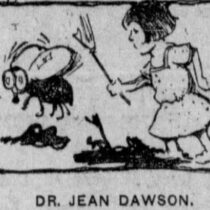Magazine

On the Fly
Typhoid, dysentery, tuberculosis–in the early 1900s, they could all be spread by flies. That’s why one woman launched a crusade to rid the city of Cleveland of its flying pests.
By Kim Clarke
Not everyone can claim to be a giant killer. But Jean Dawson could.
And she did so with gusto.
A three-time Michigan alum, Dawson was bequeathed the splendid title of “America’s Most Famous Woman Fly Fighter” for her early 20th-century assault on a winged pest that threatened young and old by transmitting diseases.
“Flies are now known to be the most deadly enemy of man,” Dawson proclaimed in 1912. “They kill more people than all the lions, tigers, and snakes, and even wars.”
As a U-M graduate student a decade earlier, Dawson was a founding member of the Women’s Research Club. The organization was in response to the 1901 creation of the U-M Research Club, whose male scientists refused to admit women. The discrimination infuriated and motivated Dawson and other women preparing for careers in science. “Jean Dawson was always the loudest and most outspoken,” said Ellen Bach, a fellow co-founder. The Bentley holds the papers of both research clubs.
Armed with her doctorate in zoology, Dawson carried out her crusade against flies in Cleveland, Ohio, first as a biology teacher and then as a city public health official.
Flies could transmit typhoid, dysentery, tuberculosis, and other lethal yet preventable diseases. It was a time when automobiles were becoming fashionable, yet horses—and their manure—still filled city streets and stables. Along with rotting garbage, the refuse was the perfect breeding ground for flies, which spread disease to human foods using their germy legs.
An article by Dr. Jean Dawson about the importance of fly removal from The Wichita Beacon, April 22, 1916, Page 15.
Dawson went after flies as a professor of civic biology at the Cleveland Normal Training School, along with the help of her students. Starting in 1911, she and her minions—all women—attacked the insects on three fronts: liquidating the “winter fly” before it had the chance to breed in the spring (“one fly killed in April is equivalent to killing thousands in August”), trapping and snuffing out those pests that managed to surface in the warm months, and eliminating fetid organic matter.
She recruited schoolchildren to be “junior sanitary police” and rewarded them for tiny corpses (10 cents per 100 flies). She recommended traps to capture and poison flies (4,000 dead critters equaled 1 pint). She distributed hundreds of thousands of fly swatters—provided by a local merchant—to carry out the slaughter. In 1915, she became chief of the city’s Bureau of Fly Prevention.
Most notably, she worked with city leaders and merchants to clean up the community and rid it of manure and garbage. Contractors hauled horse dung out of town, inspectors patrolled alleys behind restaurants and markets, and workers regularly collected trash. After five years of Dawson’s work, Cleveland saw a noticeable decrease in flies and disease.
Dawson pointed to the testimony of a businessman: “In past years flies rose like steam before you as you passed in front of the stalls in the market. Why, you could not tell the color of the meat for flies in those days.”
Cleveland, Dawson declared, was “practically the only flyless city in America.”
Dawson moved from Ohio to Florida to live on a 50-acre fruit ranch with her scientist husband, Clifton F. Hodge. As she wrapped up her fly fighting in Cleveland, the two collaborated to write a book about the power of “civic biology” to fight public health crises. In the Sunshine State, they studied oranges and other citrus. She died in 1948 at 75.
